The Real Alcazar of Seville is the must-see palace you shouldn’t miss while you are in Spain. Planning to visit the Seville Palace? Here’s what you need to know before you go.
So, you are planning to travel to one of the jewels in southern Spain’s crown: The Royal Alcazar of Seville, which was built in the 10th century.
If you are considering whether you should visit Seville’s elegant palace, I have two simple words of advice to give…
Do it.
This UNESCO World Heritage site is an eclectic collection of royal palaces. Built over a period of several centuries and accompanied by lush gardens, they should be at the top of any itinerary for Spain.
OK, so that’s the why. That leaves the how.
We all love to pretend that we are footloose and fancy-free, turning up wherever whenever it suits us. In truth, reality bites.
There’s nothing like standing in the 40-degree (celsius!) heat in the middle of a long queue for Seville’s Alcazar to make you wish that you’d just planned that little bit ahead.
So here we are, a complete guide to visiting the Alcazar of Seville.
How to Visit the Real Alcazar of Seville: At A Glance
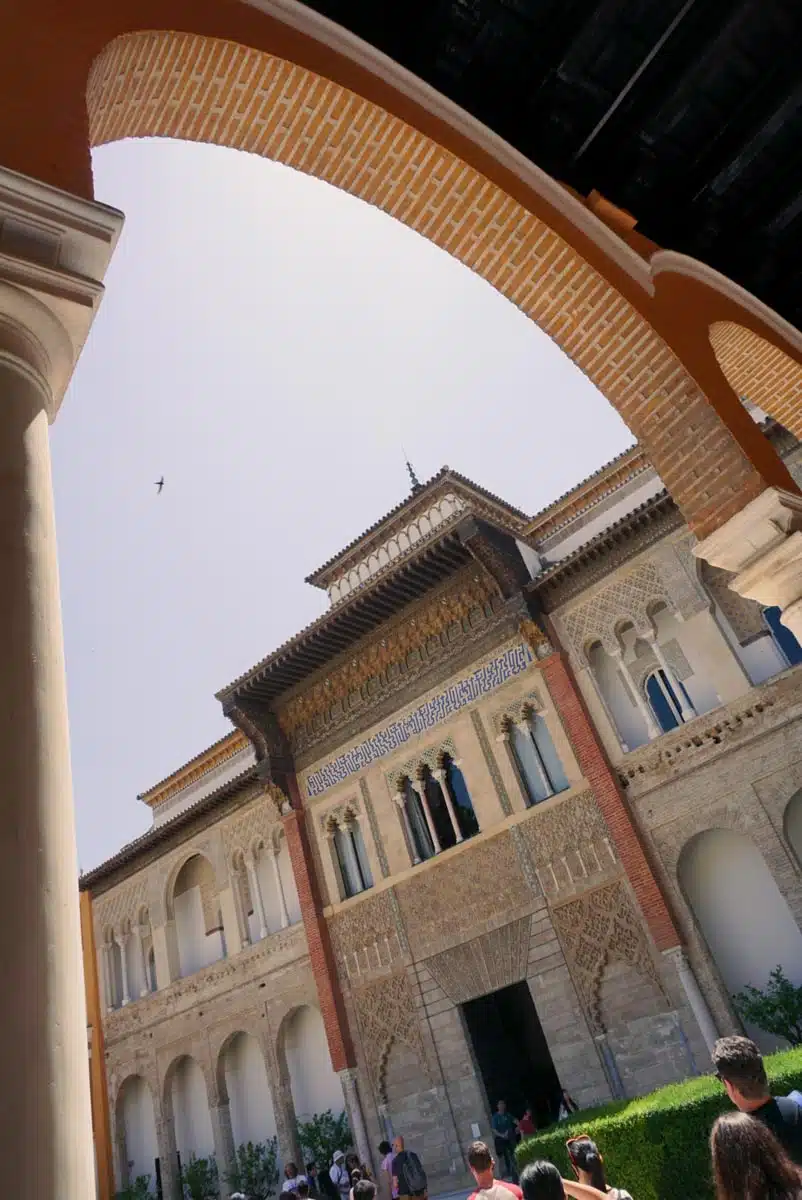
Your three main options for visiting the Real Alcazar of Seville are:
- Book onto a tour that includes fast-track entry.
- Book tickets in advance on the Alcazar’s website.
- Buy tickets on the door.
Book Onto a Guided Tour of the Alcazar of Seville that Includes Fast-Track Entry
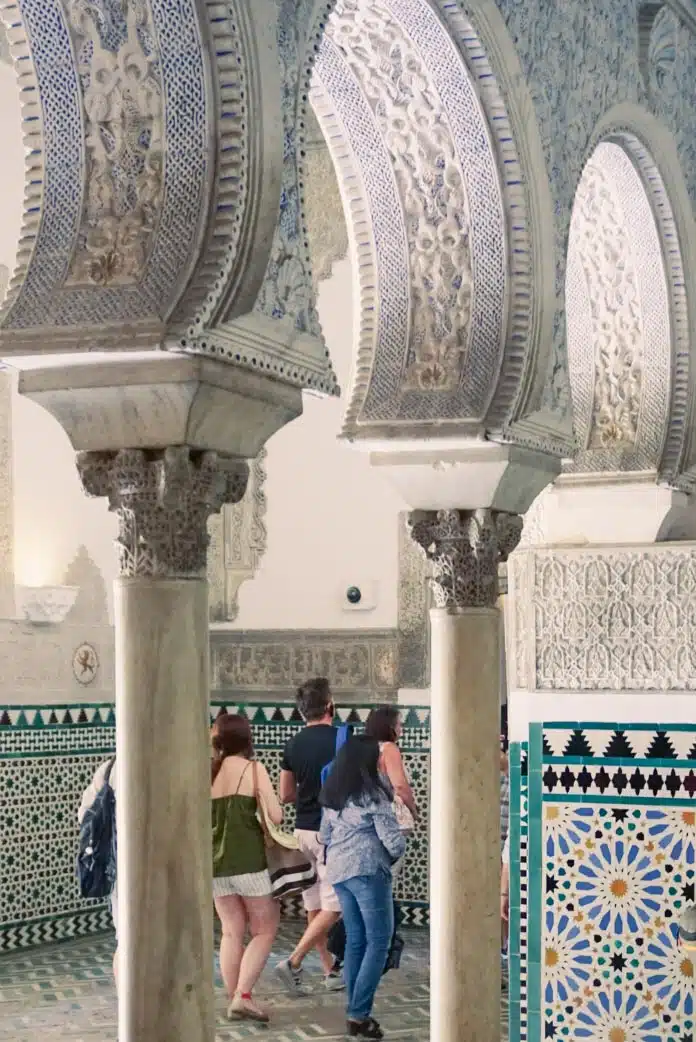
Book yourself a guided tour of the Real Alcazar. Make sure that it includes fast-track entry to the palace in the tour price. That is what I did and I would highly recommend it.
Why do I recommend this as the best way to see the Alcazar of Seville? Firstly, by booking a guided tour, you get to skip the queue. On top of this, the guide provides invaluable insight into the history and the stories that bring the palace to life.
The buildings of the Alcazar are packed with so much history and so many stories that it would be a shame to miss them (and there’s only very limited signage within the Alcazar itself telling you what you are seeing).
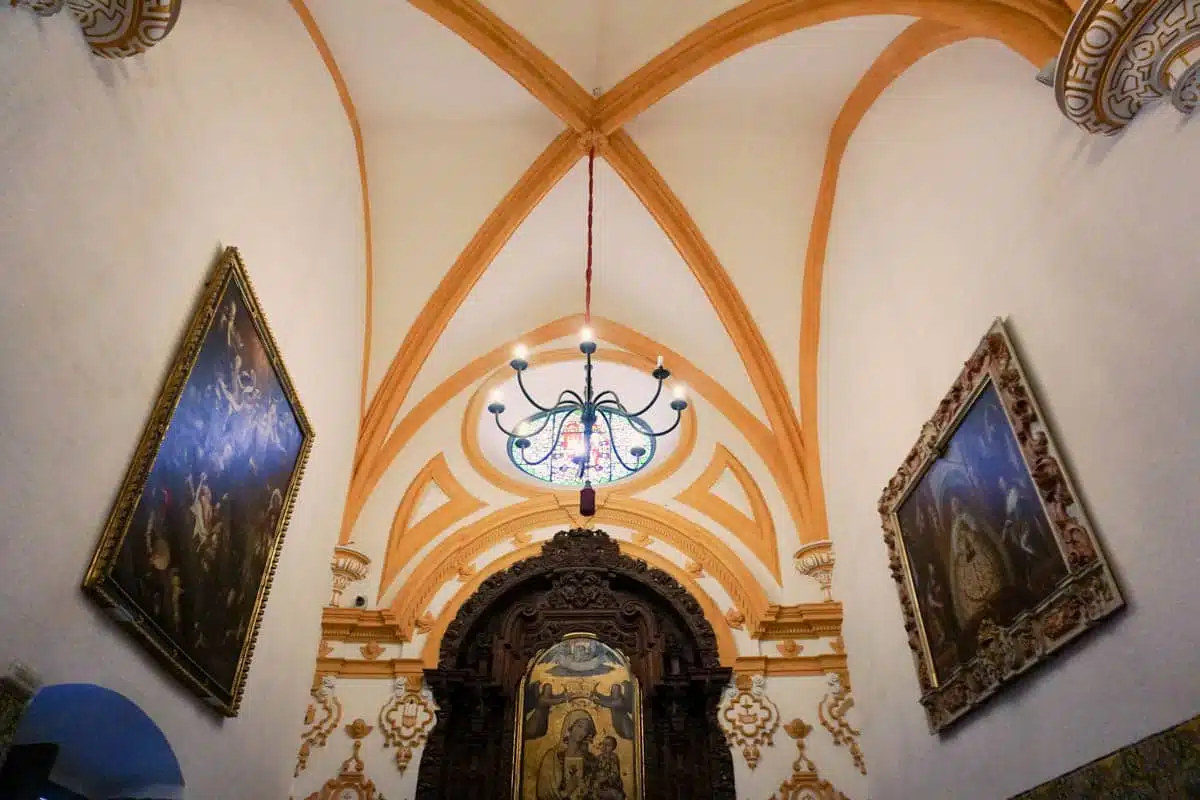
I booked this 1.5 hour guided tour of the Alcazar. It costs £31 per adult. Of course, the ticket comes with skip-the-line entry, which itself is invaluable.
Note: This tour didn’t include a visit to the upstairs Royal Quarters (this requires a special ticket as access to this part of the palace is restricted).
In all honesty, I thought that 1.5 hours and then being able to spend as much time as I wished exploring the palace after the tour was the perfect combination. The upstairs quarters are not nearly as interesting either, so I was happy to skip.
Book the 1.5 hour tour of the Alcazar
On The Door (Free Entrance on Mondays)
On the face of it, simply turning up and buying your tickets for the Alcazar of Seville on the day seems like the easiest option.
In some ways, it is. It’s the cheapest way to visit the Alcazar (all online ticket bookings are subject to a €1 fee) and it takes zero pre-planning.
Unfortunately, things are never as simple as they seem.
Queues to buy tickets for the Alcazar Sevilla can be long, slow and very, very hot. Temperatures in Seville reach 40 degrees celsius during the summer months when the Alcazar is most popular and if you’re on a relatively tight Seville itinerary, you won’t want to waste it in a queue.
Try queueing in the blazing sun for any period of time and I pretty much guarantee you will start to wish you’d booked your tickets to visit in advance.
Entrance to the Alcazar is free of charge on Mondays. Though, as always, there’s a catch. From October to March, you can visit for free between 4pm and 5 pm. Between April and September, free access is between 6pm and 7pm only.
Note: Alcazar Seville entrance fee: €13.50 per adult, student tickets €6, children under the age of 13 are free. Tickets including access to the Royal Quarters are €19 for adults or €11.50 for students.
Book In Advance on the Alcazar’s Website
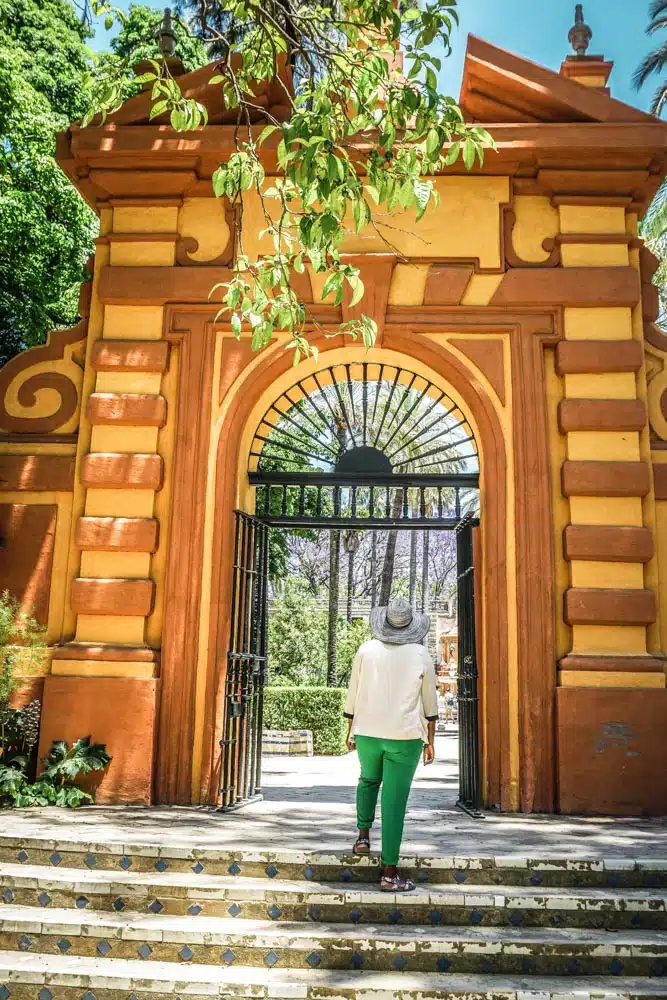
Your second option for buying tickets to the Real Alcázar of Seville is to book directly on the Alcazar’s website.
Sure, you pay a €1 surcharge for the privilege of booking online, But any euro that allows you to skip past the queues and straight in for the fun stuff is a euro well spent in my books.
Tickets including access to the Royal Quarters are €17 for adults or €8.50 for students, €5.50 for children under the age of 13.
Alcazar Seville entrance fee: €12.50 per adult, student tickets €4, children under the age of 16 €1. Entrance to the Alcazar on Mondays is €1 for everyone between the times I mentioned above.
Should You Take a Guided Tour of the Alcazar in Seville?
The answer to this completely depends on what you want to get out of your trip to the Alcazar.
Happy enough to wander about? Just want to spend time marvelling at the beautiful interiors and exteriors of the Alcazar during your trip to Seville without having to know the detail behind it?
Then you probably don’t need to book a guided tour.
You can still see a lot without a tour
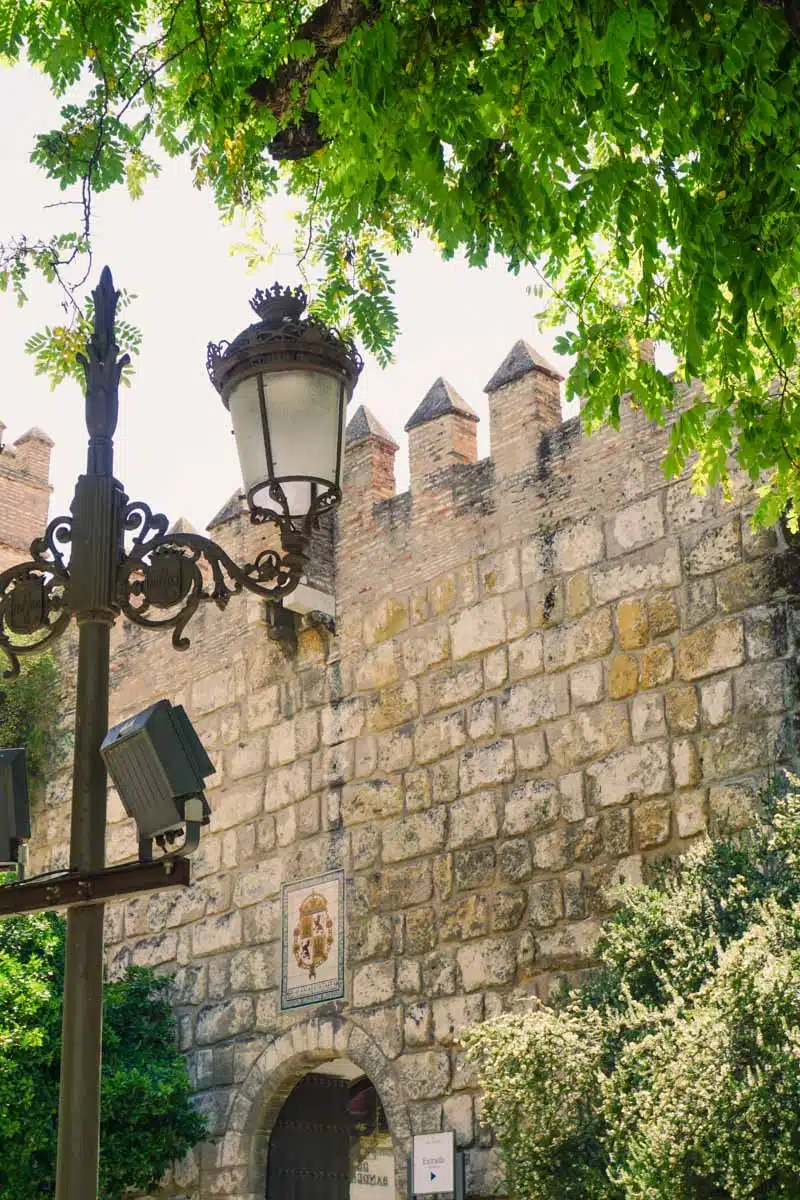
It took me a long time to really understand the appeal of guided tours. I spent years thinking that I could just read the leaflets and signs and they’d provide me with the same level of information, right? Wrong.
As with most tourist attractions, the information provided within the palace is pretty sparse – which isn’t ideal as it’s one of Seville’s most interesting attractions.
A guided tour is the easiest way to learn about the Alcazar’s long and interesting history and, depending on the tour you take, it doesn’t cost that much either.
The tour I took cost £31 per adult. It provided so much information about what we were looking at… not to mention scurrilous gossip from leading characters in the palace’s history.
I can’t imagine having enjoyed the visit nearly as much without it.
Real Alcazar of Seville, Reales Alcazares or the Alcazar Palace?
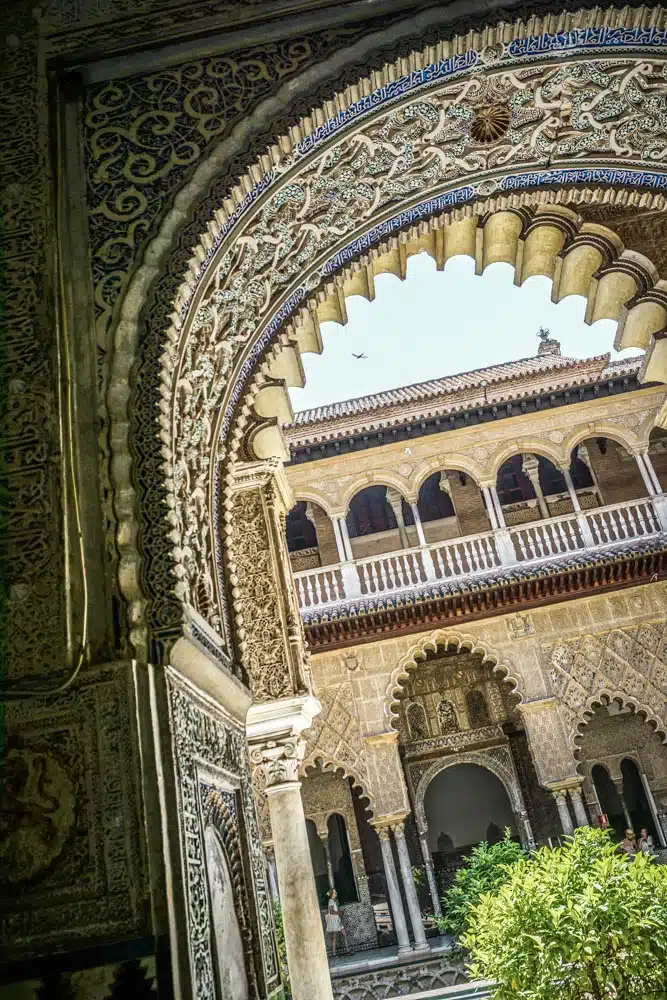
Seville’s Palace goes by several names. The Real Alcazar (Royal Palace), Reales Alcazares (Royal Palaces) and the Alcazar Palace being three examples.
Sometimes it’s also referred to as the Alcazar Castle in Seville, but it’s definitely a palace and not a castle!
Interestingly, our guide, Andres, told us that actually, the Reales Alcazares is the correct name as the palace is actually a number of palaces built by different rulers over different times.
It can get a bit confusing when you throw the fact that the official website calls it the Real Alcazar into the mix.
Who knows?
History of the Seville Palace
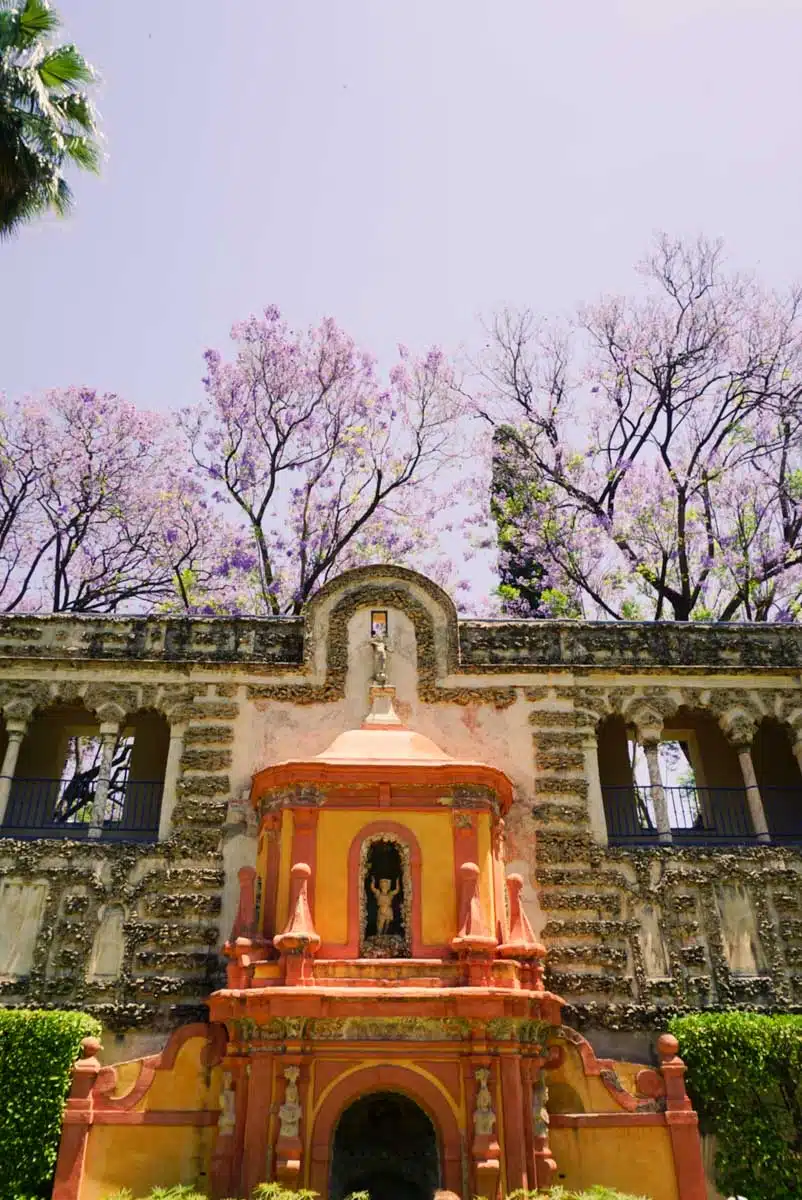
The Alcazar’s history dates back to 913: a time when Seville was under Moorish rule.
The then Caliph of Cordoba, Abdurrahman III an-Násir decided to create a new seat for the Umayyad government in Seville. A series of palaces were built, then extended over time, becoming royal palaces in the process.
Seville was re-conquered in the 13th century, but the Castilians decided to keep the Real Alcazar as a royal residence.
Though much of the palace we see today dates from after the 13th century, you can still spy some of the original Islamic architecture in the Patio de Yeso, Patio del Crucero, Patio de la Casa de Contratacion and the Sala de Justicia.
A period of cultural fluctuation and exchange followed during subsequent centuries.
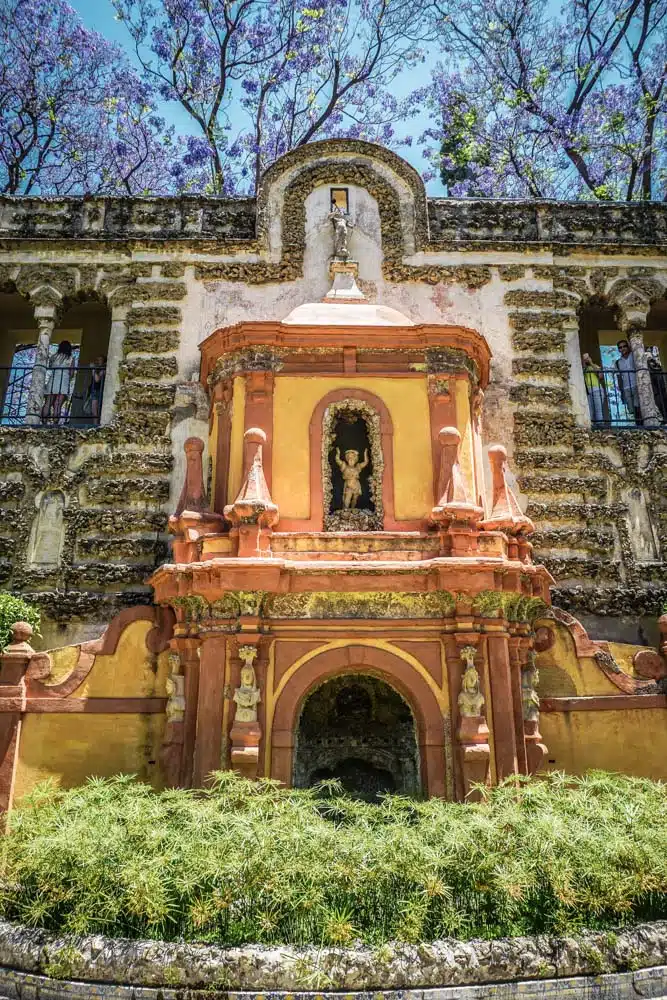
The end result was that a lot of the decorative styles prevalent in Moorish architecture became fashionable once again. These were used extensively during the building of the central palace complex by Pedro I (Peter I).
The Alcazar continued to evolve as times changed and fashions moved forwards.
New sections and buildings were added: each in a different style.
From the Italian Renaissance-styled upper level of the Patio de las Doncellas to the extravagant altarpiece in the Admiral’s room, a walk through the Alcazar is a journey through time.
Want to know more about the history of Spain? Check out these interesting facts…
The Alcazar of Seville and Game of Thrones
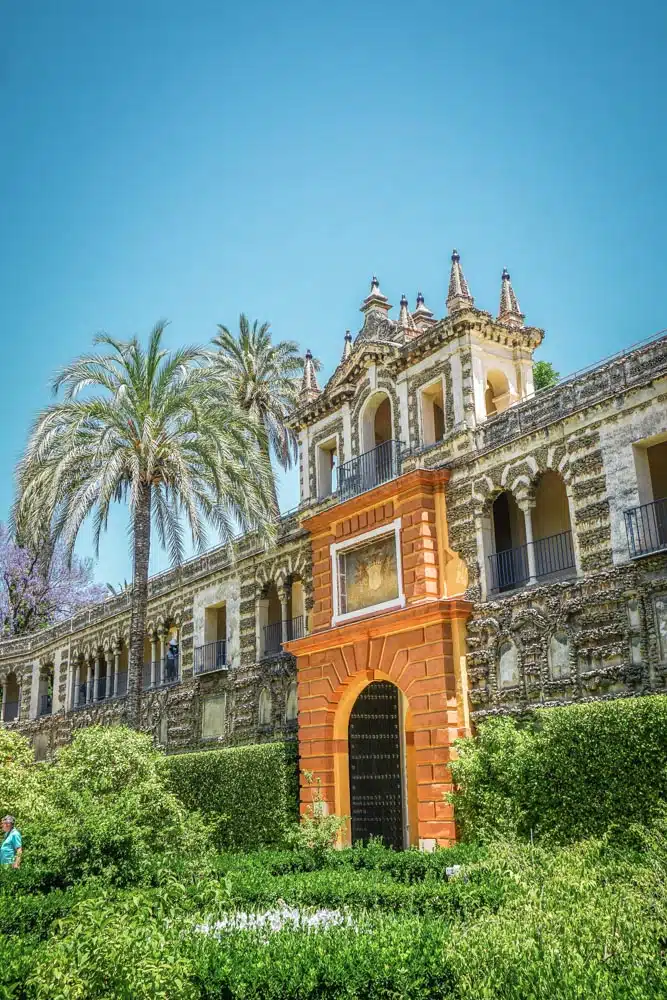
Any Game of Thrones fans in the house?
I’m fully obsessed with the series, having watched it a rather embarrassing five times. Obsessed.
So you better believe that I was more than low-key excited when I found out that the Alcazar of Seville is the setting for Dorne in Game of Thrones.
I spent some time in Iceland earlier this year, where they also film the series and one thing is for sure – these dudes know how to pick a location.
The Alcazar first makes an appearance as Dorne’s Water Gardens in Series 5 of the hit programme.
Who can forget the scenes? Gouty old Doran Martell chills against the backdrop of the Alcazar’s rather spectacular architecture and gardens.
We watch Ellaria and the Sand Snakes fighting, Prince Trystane wooing Princess Myrcella and poor old Doran caught up in the political shizzstorm that is life in the seven kingdoms – all from this palatial setting.
Just don’t get so excited by the idea that you can justifiably pretend to be one of the sand snakes fighting for the honour of dead Prince Oberyn that you slightly scare your tour guide (no, this most emphatically did not happen to me).
Want to go all out with the GOTR fandom? There’s an actual Game of Thrones tour of Seville and Italica including a tour of the Alcazar and a jaunt to nearby Italica for even more location spotting.
Italica is a stunning location anyway – but not the easiest to get to unless you go on a tour, so it’s worth doing this tour anyway.
A Virtual Tour of the Real Alcazar Seville
Who could resist the elaborate arches and water-filled gardens of the Alcazar?
You could easily breeze through, snapping picture after picture, without delving into the palace’s history.
It would be a shame though: scratch beneath the surface and the Real Alcazar is brimming with stories. Every architectural detail, every room, every garden has played its part in the palace’s story.
Want to take a peek at the Alcazar’s main buildings and gardens? Here’s a sneak preview of some of my favourite spots.
Puerta del León (Lion’s Gate)
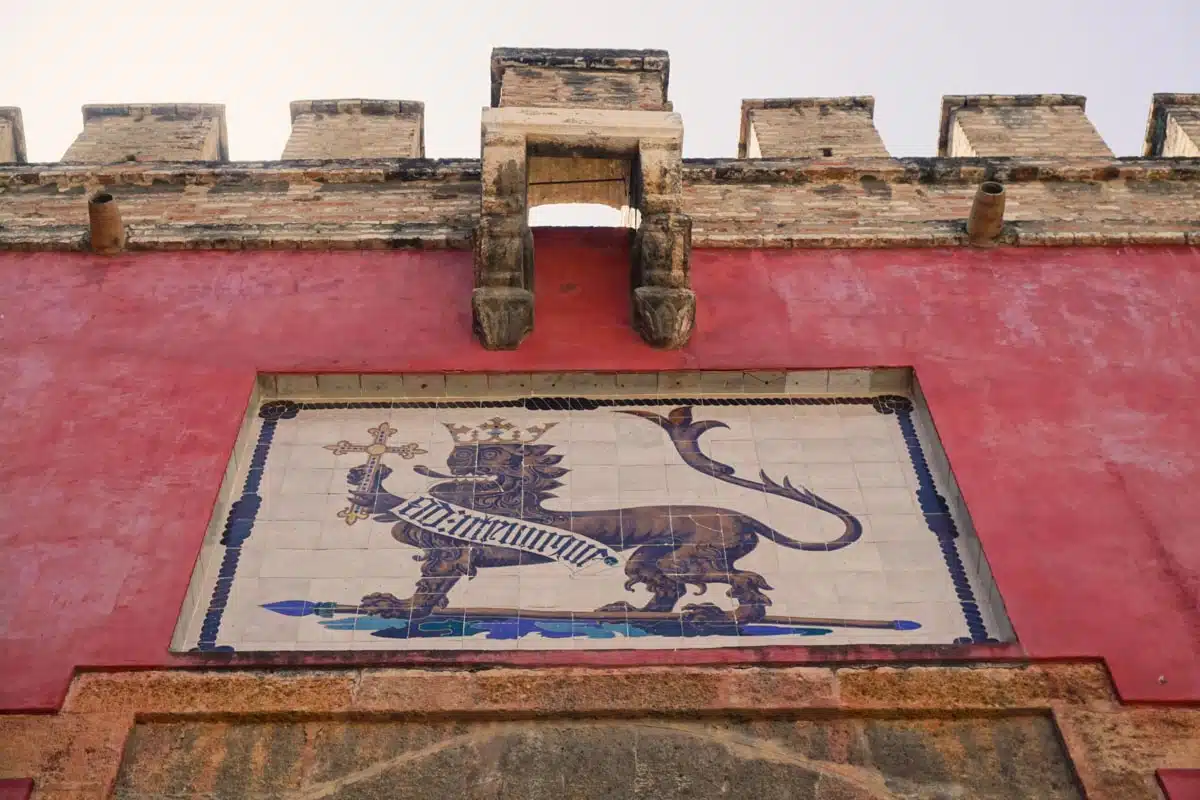
The magic begins before you even set foot inside the Alcazar. Prepare to be captivated by the majestic entrance of the Seville Alcazar through the Puerta del León.
When you reach this grand gate, look up and you’ll see the famous stone lion sculpture, which welcomes visitors with an air of regality and history. The intricate details carved into the stone showcase the original artistry (or… not so much; he does have quite a weird face).
Palacio del Rey Don Pedro
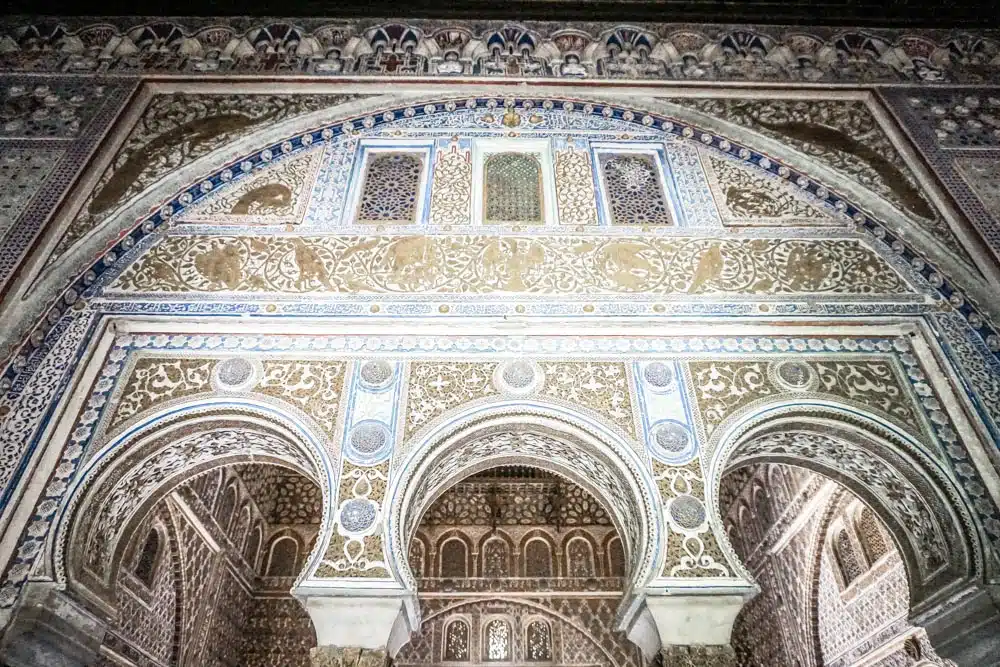
The Palacio del Rey Don Pedro is where things start to get really exciting.
Peter was a Christian King who ruled in Seville after the reconquest, but he appreciated and enjoyed the Moorish style of architecture and used it as the inspiration for the designs of his palace in the Alcazar.
Muhammed V, ruler of the Nasrid dynasty in Granada at the time, sent many of his craftsmen to come and work on the Alcazar.
Though the two regions were divided by ideology and religion, there was an understanding between the two rulers.
That’s why you can see the Nasrid motto “There is no conqueror but God” inscribed over the the entrance to the Palace of Peter I in the Alcazar.
Patio de Las Doncellas
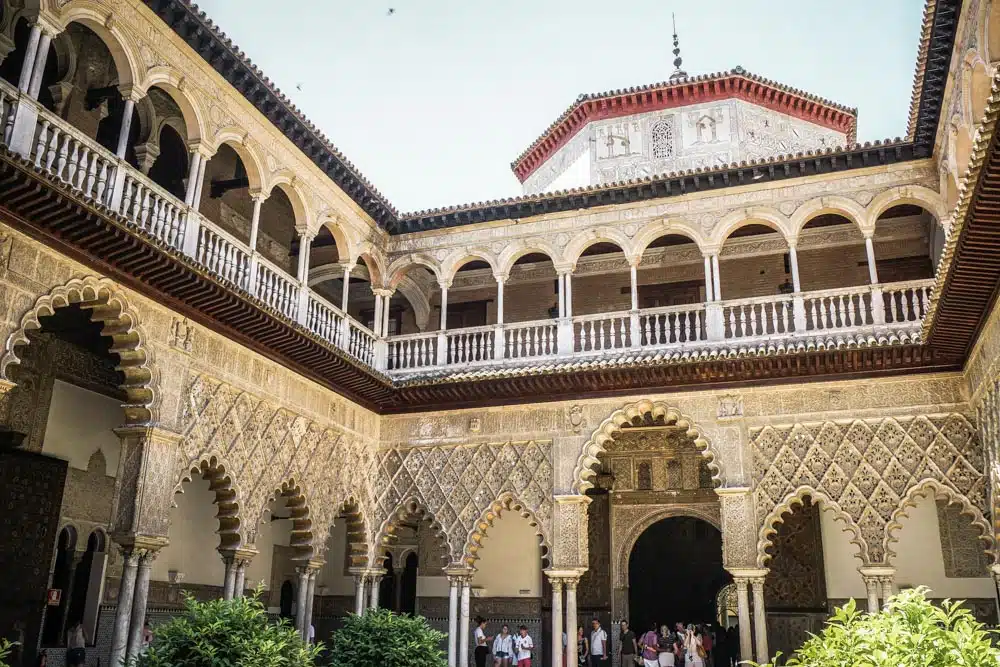
It was rumoured for a long time that the Doncellas (Spanish slang for beautiful or maidens depending on who you ask) after which this patio was named was Peter I’s harem (giggle).
Unfortunately (or fortunately depending on how moral you are), it’s more likely to refer to the beautiful white flowers that they used to decorate the central courtyard.
Decorated arches contain Christian and Muslim signs and symbols – like the Hand of Fatima holding a plant that symbolises life.
The patio was the centre of official life – so where the royals would entertain guests and fulfil their royal duties before retiring to other, more private parts of the Alcazar.
PS – though it might look like it was all built at the same time, the second floor of this part of the palace was actually added in the 16th century.
Cuarto del Principe (King Pedro’s Bedroom)
Pop into the Cuarto del Principe to see the oldest ceiling in the palace. Check out the star pattern that could fool you into thinking that you were looking at the night sky (well, almost).
Patio de Las Munecas (The Patio of the Dolls)
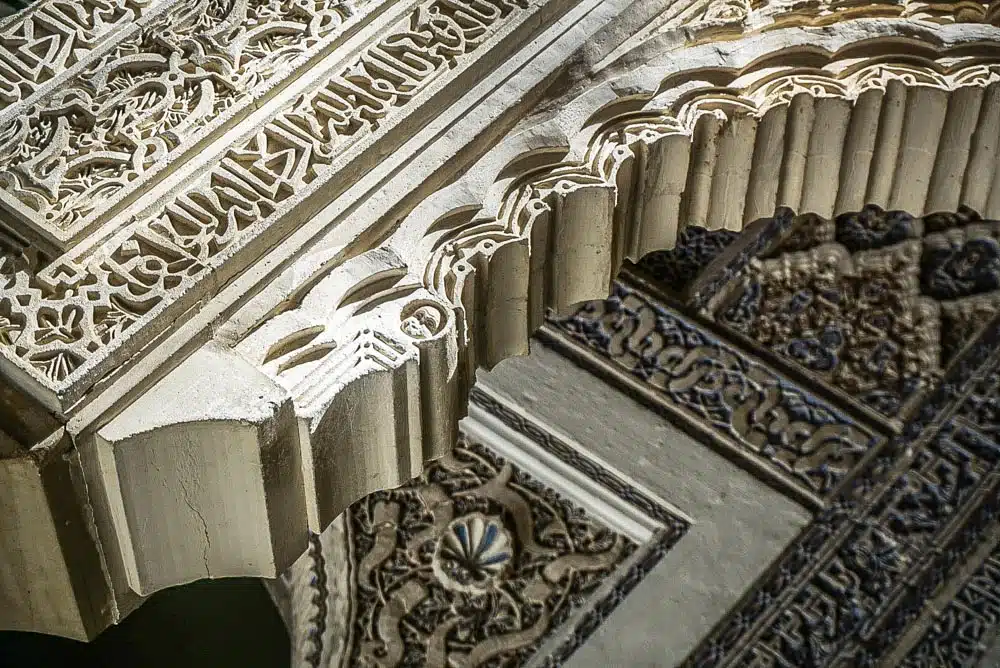
There is a reason for the slightly strange name: The Granadian craftsmen who created the Patio used a doll’s face as a sign of their work.
If you look you can still see the small faces on one of the arches in the corner of the patio.
Salon de Los Embajadores (The Ambassador’s Room)
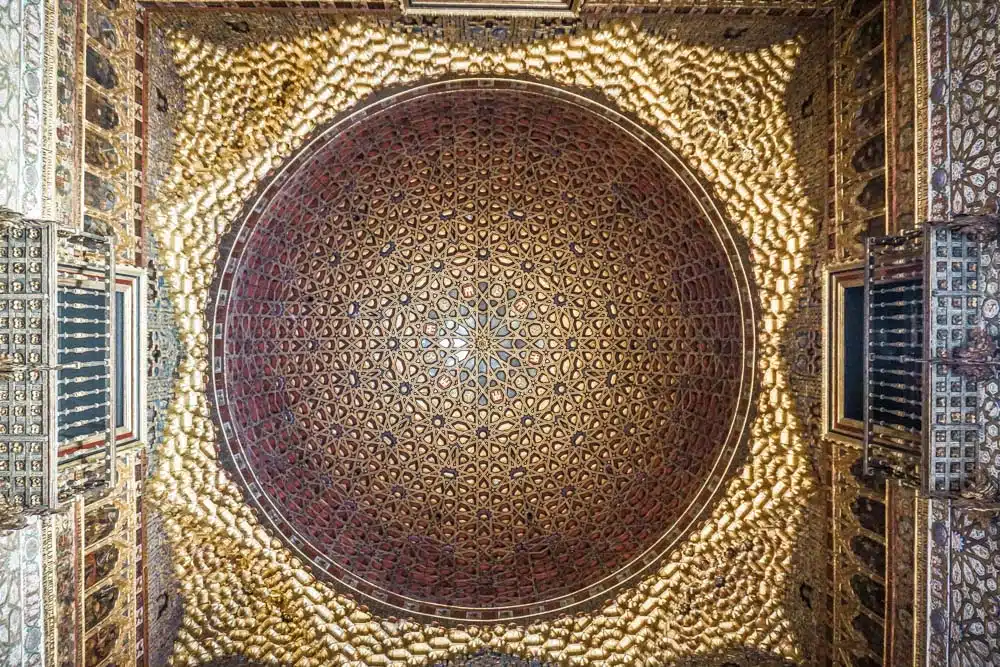
The most impressive room in the Alcazar, the Ambassador’s Room (also nicknamed the Half Orange Room after the huge dome that dominates its interior) is nothing short of breathtaking.
Decorated largely in gold (representing the strength and the power of the monarchy), no detail has been overlooked.
From the jalousie windows to the baroque-style balconies that were added later, the Ambassador’s Room was meant to impress foreign visitors and dignitaries. Several centuries later, it still does.
The Chapel of the Gothic Palace
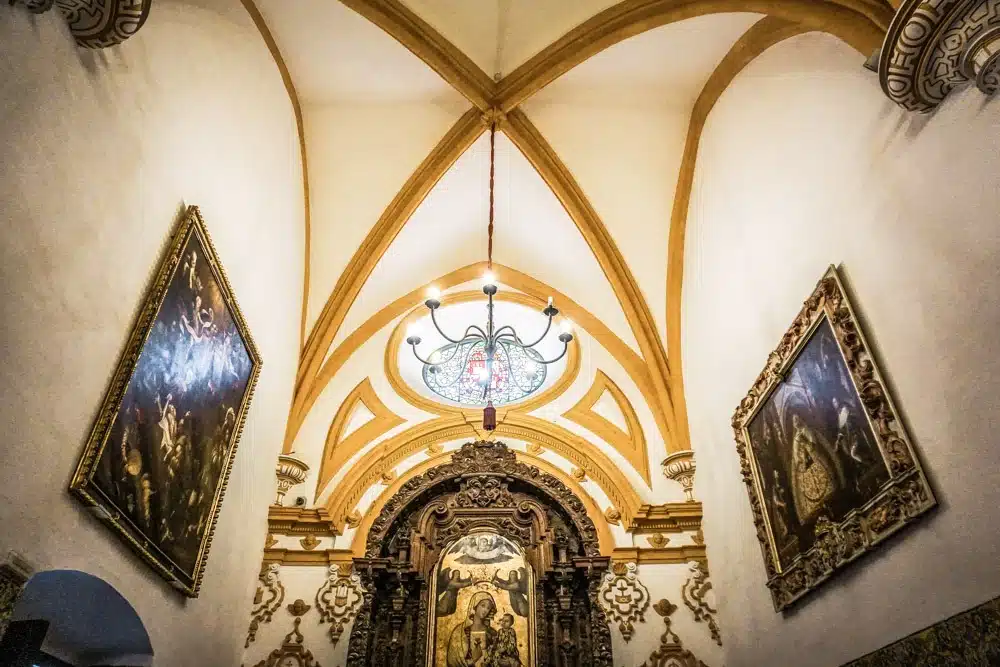
There’s not much that remains of the Gothic Palace today – much of the building was damaged by aftershocks from the Lisbon Earthquake in 1755.
What does remain is starkly different to the Muharajjin-style decor of the Palacio del Rey Don Pedro.
Instead of earthy tones and natural materials, the chapel is painted in an exuberant yellow, with pictures of animals and humans (neither of which are permitted in Islamic art).
The Alcazar Gardens
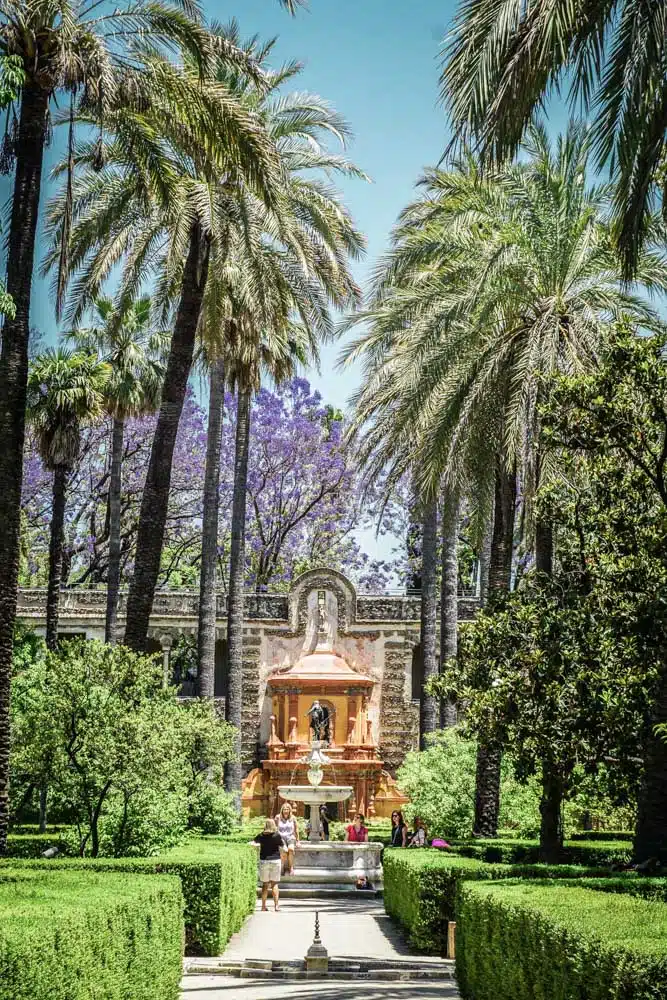
If you thought you’d seen it all, wait until you see the Alcazar’s gardens.
An eclectic mix of horticultural styles (there’s even a so-called English Garden – a formal garden with lawn and trees), decorated with ornate fountains, the gardens are the perfect end to your trip to the Alcazar.
Be warned, you need around six hours to explore the gardens full. If you’re planning to spend this much time, don’t forget to bring a hat, water and sunscreen!
Galeria de Los Grotescos
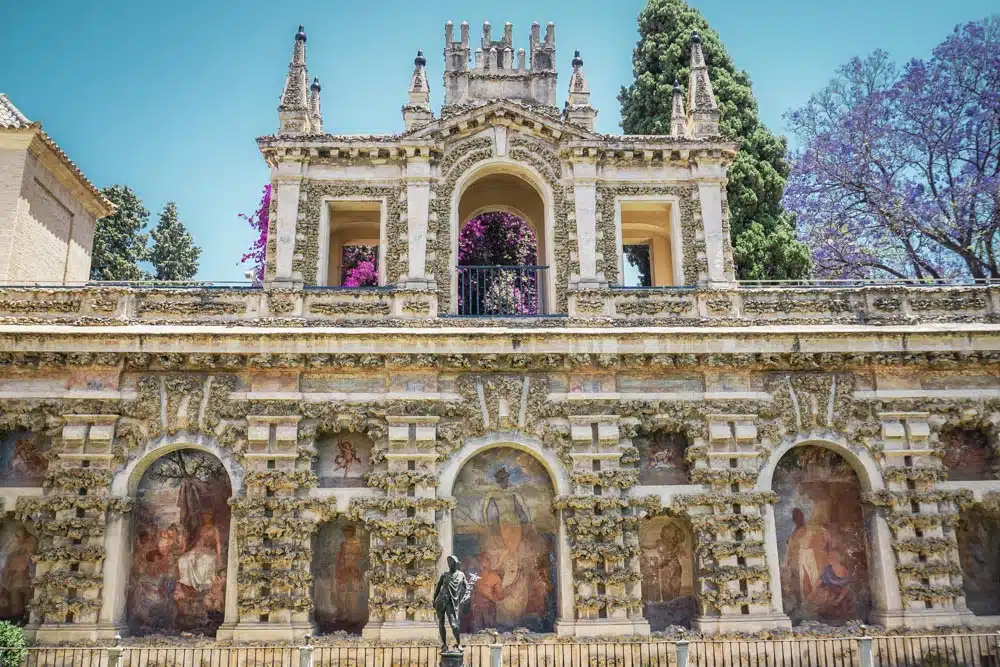
Don’t miss the Galeria de los Grotescos. It’s the first thing that you see as you enter the gardens from the Gothic Palace… you know, covered in opulent frescoes and fronted by a large pool – it’s quite the sight.
The Water Organ
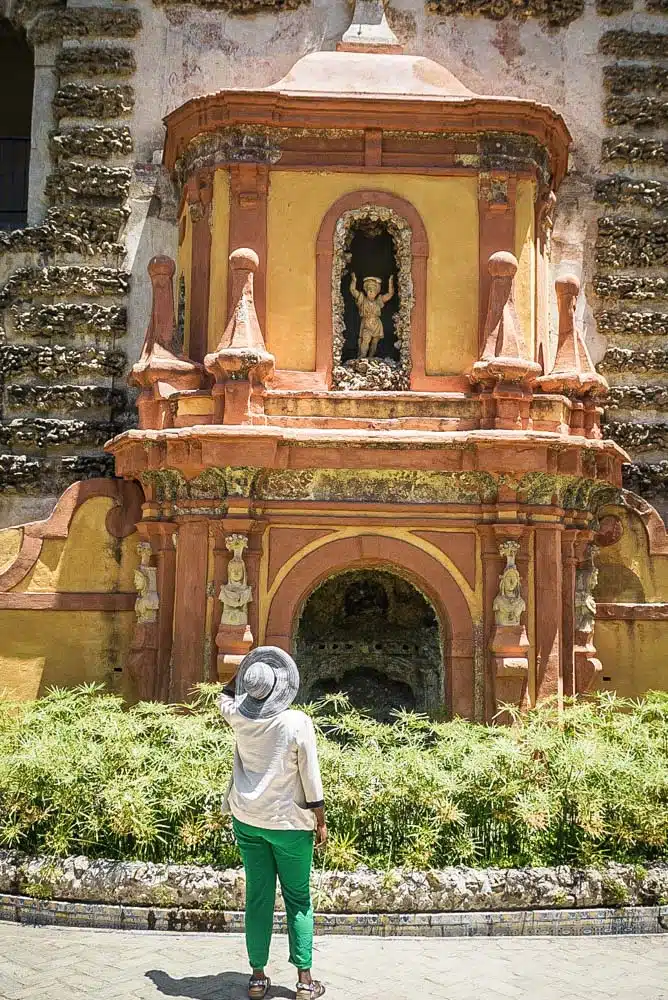
Have you ever heard of a water organ?
This quaint little showpiece works with water rather than air and is the only one of its kind in Spain.
Once rather fashionable, they’ve all but died out these days. Swing by on the hour when the organ bursts into life and plays a little song. It’s pretty cute.
Baños Doña María de Padilla
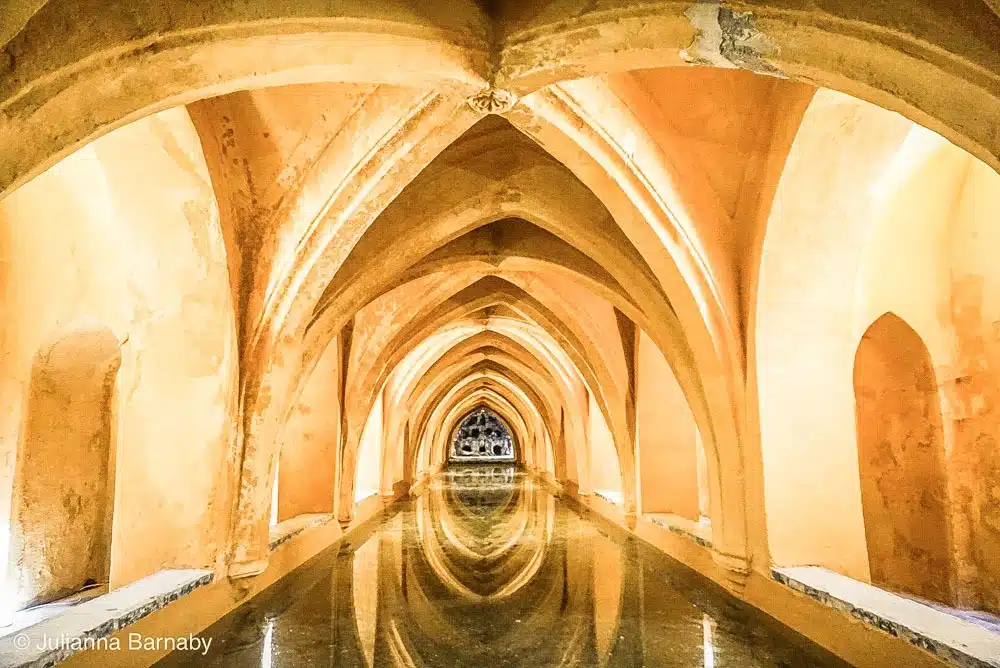
How striking is this?
The Baños Doña María de Padilla actually forms a part of the Gothic Palace (which stands above it) but is accessed through the gardens.
Tip – it’s also blessedly cool in the heat of the day, though it’s still pretty crowded.
Which is Better? The Alhambra in Granada or the Real Alcazar of Seville?
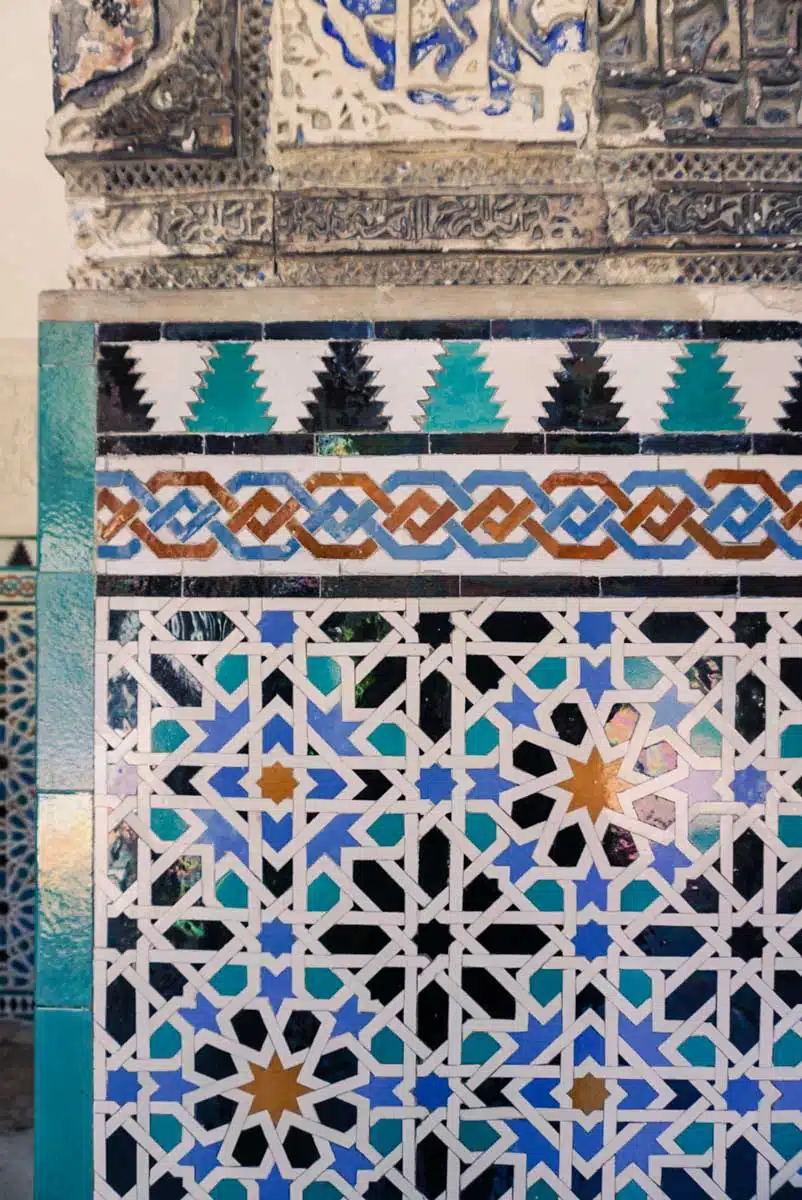
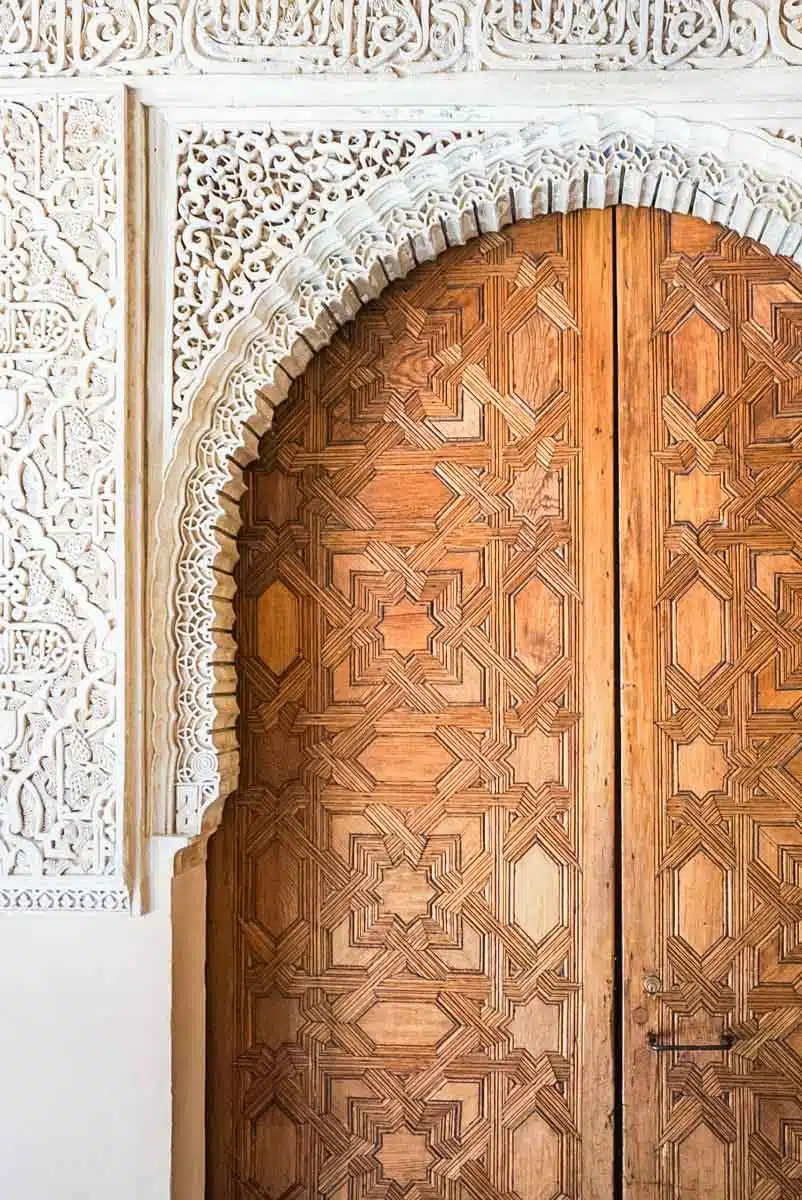
It’s difficult not to make comparisons between the Alcazar of Seville and the Alhambra in Granada: not only were the two buildings built around the same time, but many of the craftsmen who worked on Granada’s famous palace also worked on the Alcazar.
It’s a difficult decision to say which is better.
Sure, the Alhambra might boast stunning views of Granada and its surrounds, but interiors-wise, the Alcazar might just pip it to the post – thanks to the fact that it has always been a royal palace and was never abandoned.
I think you’ll just have to go and decide for yourself…
Visiting the Alcazar of Seville: Practical Information
Where to Stay in Seville: Legado Alcazar
Where better to stay during your visit to the Real Alcazar of Seville than in a cool boutique hotel overlooking the palace’s gardens? This converted 17th-century mansion is a real gem: make sure you book well ahead as rooms are in hot demand.
Check prices and availability
Alternatively, check all accommodation in Seville.
How Long to Visit the Alcazar of Seville?
I’d suggest four hours to visit the Alcazar of Seville: two for exploring the palaces and two for exploring the gardens.
Just make sure you have plenty of water and sunscreen for the gardens – the Sevillian sun is hot, hot, hot.
What to Pack / Wear for Your Visit to the Seville Palace
- Comfortable walking sandals or shoes (I swear by Tropicfeel shoes)
- Lonely Planet’s Spain Guide
- A broad-brimmed hat
- A refillable water bottle
- A good quality camera
- Sunscreen
- Sunglasses
- Universal travel adapter
Alcazar Seville: Opening Hours
Monday to Sunday 9.30am to 5pm.
Closed on 1st and 6th January, Good Friday and 25th December.
Address
Patio de Banderas, 41004 Seville, Spain
Alcazar: Map
Love this? Save on Pinterest!
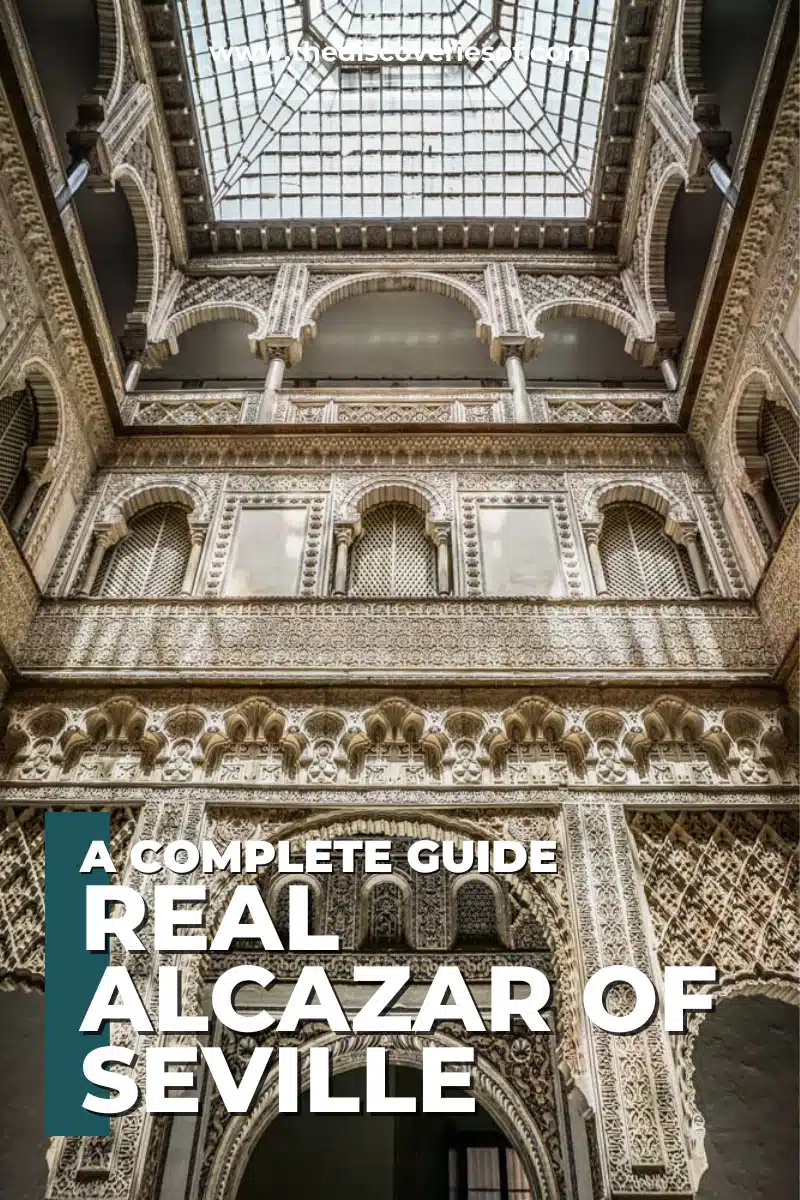
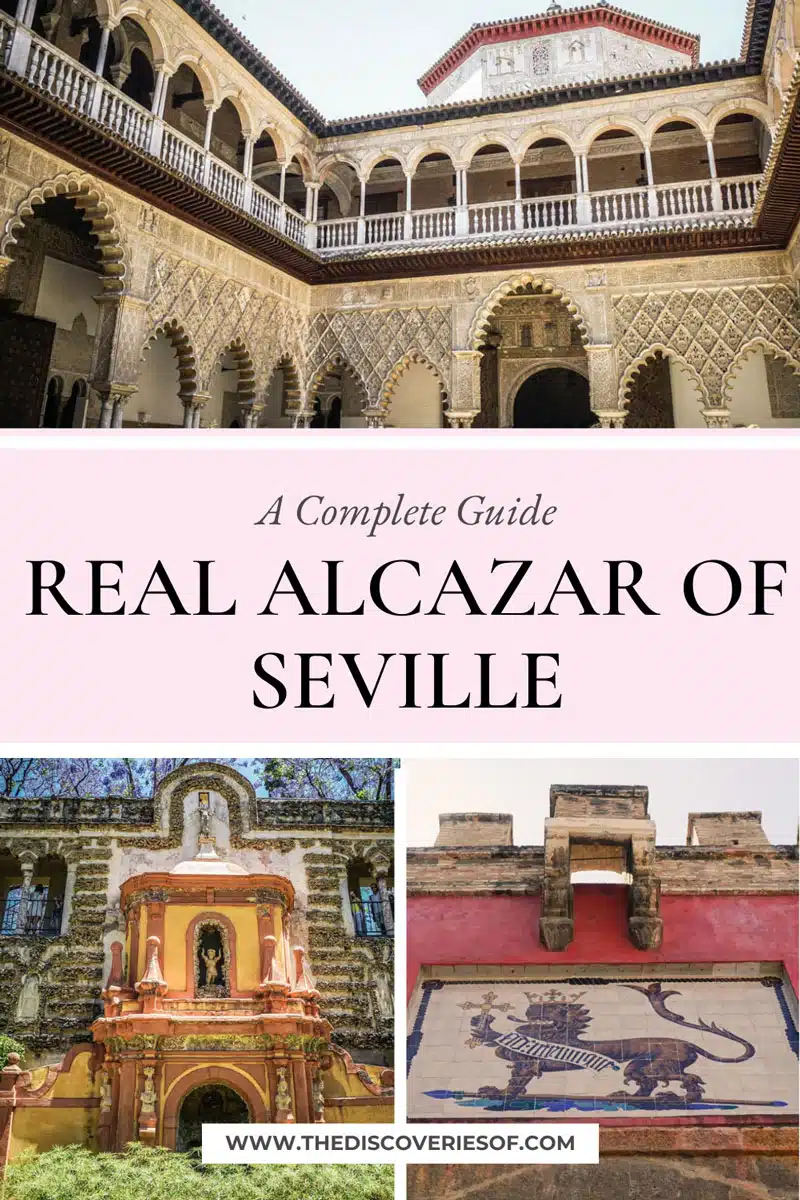

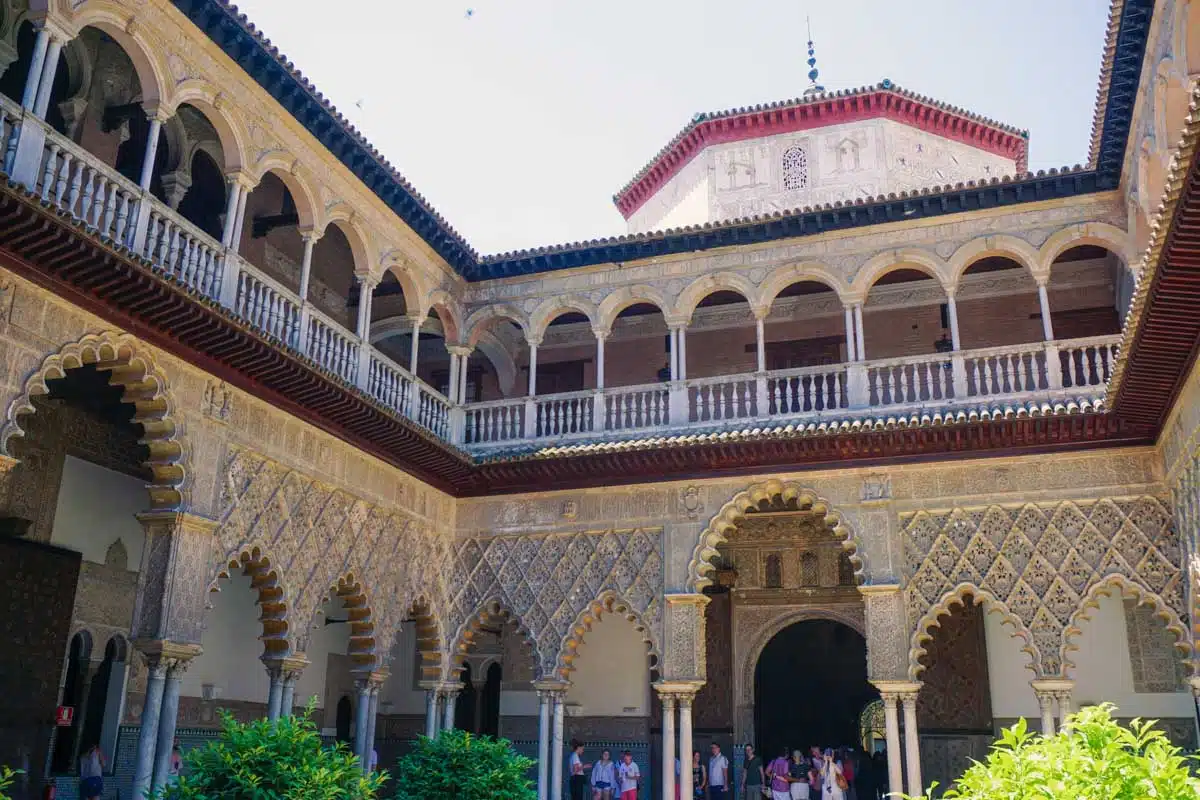

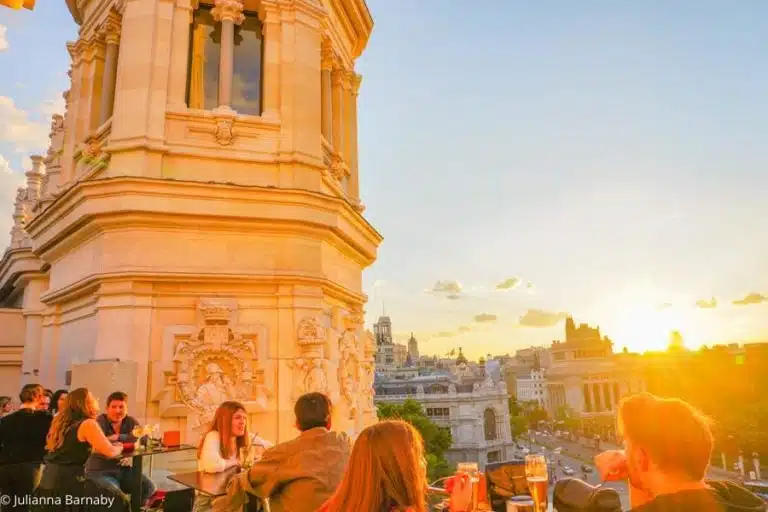
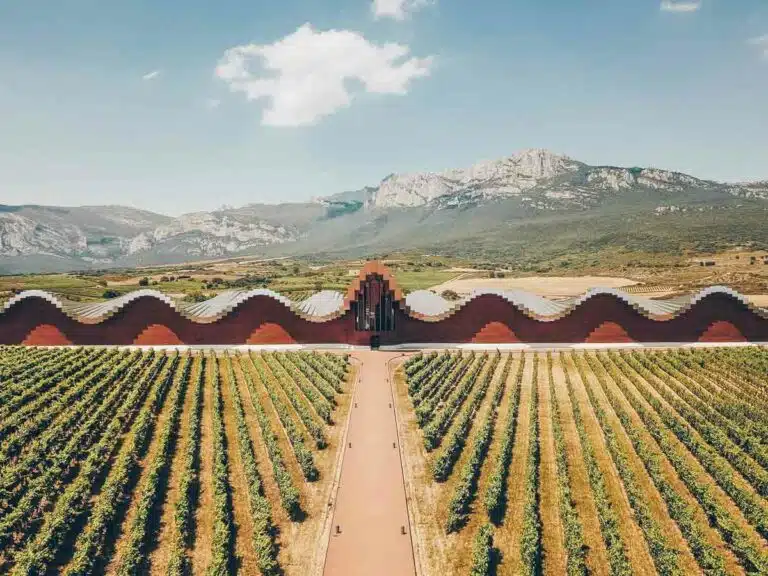
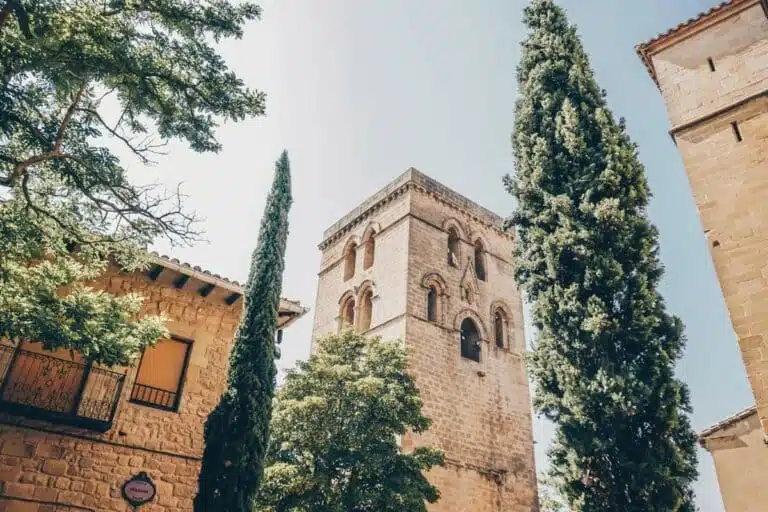

Hi, great guide, all the info will be very useful come our trip in a couple of weeks’ time.
Just wanted to ask a question to see if you knew the answer…
We have booked the tickets on a Monday at 1630, does that mean we will only get 30 mins to explore or are you allowed to stay in with a later closing time?
Thanks
Hey – so glad you found it useful. The Alcazar is such a gorgeous destination with so much history – you’ll love it. I’m really sorry but I don’t know the answer to that – I suspect that they will let you stay in later as it would be rather churlish to only allow you half an hour to explore the whole complex (and, when I’ve been to other Spanish historical sites late in the day, that’s been the case) but I can’t say for sure. I hope you have a great time though.
Hi,
Great description of Alcazar. We unfortunately had to delay our trip to Spain because of the global pandemic, we are hoping for summer of 2021. I have one question, so many posts talk about the 3 lineups and how confusing it is to find the right one? any help ?
PS: I will definitely buy online tickets.
Hi Sonal – thanks for getting in touch. I can’t say that I found it that difficult, if you’re unsure there are normally plenty of people to help when you get there.